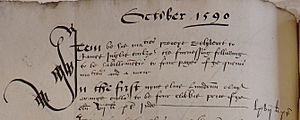Treasurer of Scotland facts for kids
The Treasurer was a very important job in the government of Scotland before it joined with England in 1707. This person was part of the Privy Council of Scotland, which was like a group of advisors to the King or Queen.
Contents
What was the Treasurer?
The Treasurer's full title was quite long: Lord High Treasurer, Comptroller, Collector-General and Treasurer of the New Augmentation. This long name shows that the job was actually a combination of four older roles.
The Lord Treasurer's Job
Two of these jobs, the Treasurer and the Comptroller, started way back in 1425. This happened when the financial duties of the Chamberlain were given to them.
From 1466, the Comptroller was in charge of money for the royal family's household. The Treasurer handled all other money and expenses. Later, other roles were added. The Collector-General, created in 1562, managed money from church lands. The Treasurer of the New Augmentation handled lands taken over by the Crown in 1587.
Money and Royal Spending
From 1610 onwards, one person held all four of these financial jobs. Even though the jobs were effectively combined in 1635, their separate names continued to be used.
In 1581, Queen Elizabeth of England started sending money to King James VI every year. In 1599, the Privy Council of Scotland decided that the Treasurer would manage this money. It was used to buy clothes for the royal family and for Prince Henry's household. Before this, a goldsmith named Thomas Foulis and a cloth merchant named Robert Jousie looked after this money.
Between 1667 and 1682, and again from 1686 to 1708, the Treasury was managed by a group of people, not just one person. This is called being "in commission." The separate Scottish Treasury was officially ended in 1708. From 1690, the King or Queen chose one person to represent the Treasurer in the Parliament of Scotland.
The Treasurer-Depute
The Treasurer-depute was also a very important job in Scotland's government before the Union. It was similar to the job of the Chancellor of the Exchequer in England.
At first, the Treasurer-depute was just a helper to the main Treasurer. But by 1614, it became a separate job appointed by the Crown. The person holding this job would attend the Privy Council of Scotland if the Treasurer was away. By 1587, the Treasurer-depute became a full member of the Council. From 1593, and again from 1617, they also sat in the Parliament of Scotland as a Great Officer of State.
Keeping Records: The Treasurer's Accounts
The final, checked records of the Lord High Treasurer were important public documents in Scotland. These records exist almost completely from 1473 to 1635. You can find them at the General Register House in Edinburgh.
What the Accounts Show
Even the very old accounts were written on paper, not on animal skin (vellum). The spending side of the accounts, called the "discharge," was usually written in the Scots language. The income side, which included rents and fees from property deals, was written in Latin.
The details in these expense records change a lot over different time periods. For example, when Mary of Guise was Regent, she paid for her horses, clothes, and personal items separately. So, these costs don't appear in her Treasurer's accounts.
There are also extra copies of these records for the years 1574 to 1596. These duplicate books were kept by the Earl of Leven and Melville's family for many years. They were given to the National Archives of Scotland in 1944. It's not fully clear why these exact duplicates were made. They don't look exactly like the main records.
Published Records
These old documents were published in books between 1877 and 1978. There are thirteen volumes, covering up to the year 1580. The people who edited these books sometimes shortened or left out some details, especially about making costumes.
Historians often use the abbreviation TA when they refer to these published books in their research:
- Accounts of the Lord High Treasurer of Scotland, 1473–1498, vol. 1, HM General Register House, (Edinburgh, 1877).
- Accounts of the Lord High Treasurer of Scotland, 1506-1507, HM Register House, vol. 3 (Edinburgh, 1901)..
- Accounts of the Lord High Treasurer of Scotland, 1507-1513, HM Register House, vol. 4 (Edinburgh, 1902).
- Accounts of the Lord High Treasurer of Scotland, 1515-1531, HM Register House, vol. 5 (Edinburgh, 1903).
- Accounts of the Lord High Treasurer of Scotland, 1531-1538, HM Register House, vol. 6 (Edinburgh, 1905).
- Accounts of the Lord High Treasurer of Scotland, 1538-1541, HM Register House, vol. 7 (Edinburgh, 1907).
- Accounts of the Lord High Treasurer of Scotland, 1541-1546, HM Register House, vol. 8, (Edinburgh, 1908)
- Accounts of the Treasurer of Scotland, 1566–1574, vol. 12, Scottish Record Office, (1970)
- Accounts of the Treasurer of Scotland, 1574–1580, vol. 13, Scottish Record Office, (1978)


